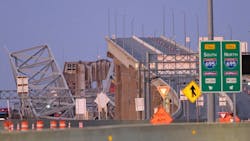One Year Later, Baltimore Rebuilds, Mourns
By Roads and Bridges Editorial Staff
One year ago, at 1:29 a.m., the Francis Scott Key Bridge collapsed when the Dali, a containership from Singapore, collided with one of the structure’s supports.
Brawner Builders, a contractor company headquartered in Hunt Valley, Md., had an eight-person team filling potholes on the bridge when a massive section of it plunged into the Patapsco River.
Two men survived. One, a state employee working with Brawner Builders’ team, ran off the bridge before it fell, and another swam ashore after falling into the river.
Six Brawner Builders employees died when the Key Bridge collapsed: José Mynor López, Alejandro Hernandez Fuentes, Dorlian Ronial Castillo Cabrera, Maynor Yasir Suazo- Sandoval, Carlos Daniel Hernandez Estrella and Miguel Angel Luna Gonzalez.
For the past year, Maryland’s construction community has been lifting up the employees of Brawner Builders, while Baltimore, the state of Maryland and the federal government have focused on rebuilding this vital bridge.
David Berkhimer, vice president of infrastructure at Brawner Builders, learned about the tragedy from a phone call in the middle of the night. He described the employees at the contractor as still reeling from the tragedy.
“There’s no recovering from that,” Berkhimer said. “It’s something that leaves a lasting mark. We can’t replace the loss that we experienced.”
The response to help Brawner Builders’ employees was swift inside and outside of the company.
Brawner Builders launched a GoFundMe campaign to support the families of the victims and donations poured in from across the globe.
Employees from other contractor companies reached out to Brawner Builders after the tragedy.
“There’s constant support,” Berkhimer said. “Our fellow contractors, they have been our biggest supporters through all of this. Because they live the same life that we do.”
As the construction community helped Brawner Builders heal, the work of rebuilding the Key Bridge began.
The first obstacle: removing the collapsed bridge and its debris from the Patapsco River. As crews got rid of the wreckage, Baltimore residents were forced to adjust to life without a vital bridge.
The bridge collapse affected traffic, businesses and daily life.
The new Francis Scott Key Bridge is expected to be completed and open to traffic by the fall of 2028.
On Feb. 4, 2025, Maryland Gov. Wes Moore announced the new design concept for the rebuild project. At the press conference, he said that the new design will honor the architectural tradition of the original bridge.
The new bridge will be Maryland's first highway cable-stayed bridge, and it will be constructed according to the most advanced industry standards and best infrastructure design practices. The bridge’s features, according to the project’s official website, will include:
- Two 12-foot lanes in each direction, 10-foot-wide outside shoulders and 4-foot-wide inside shoulders per direction of travel.
- Total bridge length will be more than two miles.
- Clearance from water to bridge deck above the federal channel will be 230 foot minimum.
- Two bridge towers more than 600-feet tall.
- Distance between main span pylons exceeding 1,600 feet.
- Total length of cable-stayed main span will exceed 3,300 feet.
- The expected life span of the bridge is 100 years.
Eight days later, the Maryland Transportation Authority (MDTA) announced three $20 million construction management and inspection services contracts, which were approved by the Maryland Board of Public Works for the Key Bridge Rebuild Project.
The contracts were awarded to Greenman-Pederson, Inc./Gannett Fleming, Inc., a Joint Venture; Michael Baker International, Inc. / STV, Inc., a Joint Venture; and AECOM Technical Services, Inc. This designates them as the construction management and inspection services consultants.
According to a press release, the construction management and inspection services consultant teams will work with MDTA’s General Engineering Consultant, Bridging Maryland Partnership, and the Progressive Design Builder, Kiewit Infrastructure Co., to serve as MDTA’s construction representative for the Key Bridge Rebuild.
“Today, we take an important step toward recovering from the tragic Francis Scott Key Bridge collapse that has affected not just Maryland’s economy, but the nation’s economy,” said Gov. Moore at the Feb. 4 press conference. “While we mark the unveiling of the new bridge design, we continue to honor the six Marylanders who lost their lives while serving our state, and their families who carry their legacy forward. Together, we will show the world what it means to be Maryland Tough and Baltimore Strong.”
Berkhimer echoed Gov. Moore’s sentiment of community strength.
“What has really caried us through is everybody knowing that we can rely on each other and lean on each other to get through this together,” Berkhimer said.
Sources: Associated Press, Reuters, KeyBridgeRebuild.com
